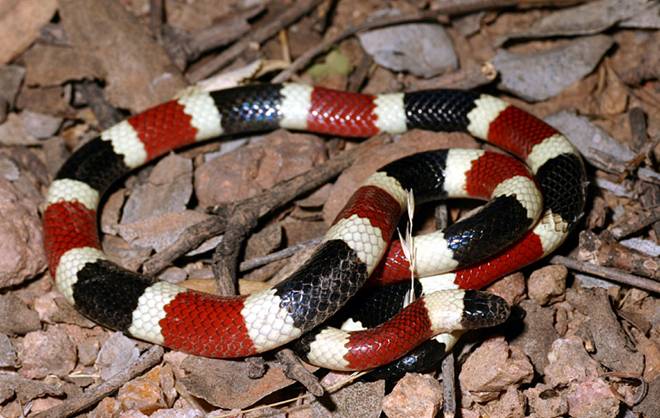
Coral Snake
Ancestory and Evolution
Body Structure
Eastern
Feeding
Reproduction
Western
Western Coral Snake

This is a brightly patterned coral snake that is related to the Indian Cobra. It is much more deadly however, as it is able to produce a venom that is twice as deadly as that of a typical rattlesnake. On a positive note, there have been no known deaths in the Desert Southwest.
This species grows to be about 13 to 22 inches long and has the girth about the size of a pencil. This snake is famous for its large red and black bands and small yellow and white rings that encircle its body.
This species of coral snake dwells in the Sonoran Desert of Arizona and North Mexico, to the southwest corner of New Mexico. It lives in the rocky upland region of the desert where Saguaro Cactus is abound. Other snakes mimic this species coloration, in particular the Scarlet Kingsnake, a non venomous species, uses this trickery to ward off predators. Yet, however much other species try to mimic it, the Western Coral snake is the only snake on the earth that has red bands that border white/ yellow.
The western coral snake is a nocturnal creature, and so hunts at night. It is rarely seen by people, and may even be called secretive, as it spends most of its life under rocks or under soil. Oftentimes, it will be out and about after the summer rains. Obviously, its coloration warns predators about its danger. If annoyed however, the snake will hide its head in the coils of its body, and raise its tail. The snake then moves the lining of the cloaca which makes a popping sound and scares enemies.
If it manages to get a bite in however, the effects of its venom a re quite drastic. The venom causes quick paralysis and the respiratory system fails to work properly. The Western Coral snake eats small snakes and lizards.
The females of this species will lay two to three eggs during the season, which is the late summer. The eggs take about 10 weeks to incubate before they hatch. When the young do hatch they are typically 7 to 8 inches long.